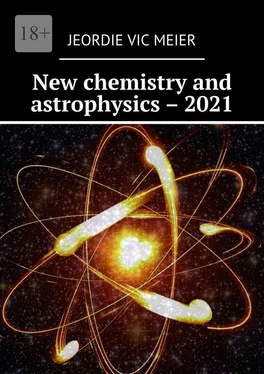I had the opportunity to touch the weakly radioactive substances that emit alpha and beta particles, I wrote that due to my weak immunity, I have a high sensitivity to chemicals, I feel their radiation and how they affect me, so I feel alpha particles as charged energy of needle, from them a state of tingling in the hand. And Beta particles are like heavy nuclei that pierce the tissue of the body and take energy. And these are definitely not helium nuclei or electrons with positrons. I can sense radiation and distinguish its types.
With radioactive radiation or an explosion, matter decays.
Man will not die if free protons, neutrons and electrons enter his body, this is normal, they are building blocks for the matter of our body, they are too light to harm us.
Proof that there are other particles in matter besides quarks that make up the proton and neutron. There are heavy metals that, when entering our body, cause it severe harm, for example, mercury, if it consisted only of protons and neutrons, it would not cause severe harm to the body, heavy particles of stardust are dangerous, which, like radiation, harm the body and are hardly washed out of the body.
Another example is the chemical formula of ethyl alcohol С2Н5ОН, I think that this is a mistake, if alcohol consisted only of these substances, it would be harmless. Alcohol undoubtedly contains heavy particles of stardust. In chemistry, many chemical formulas of substances are not correct.
*Scientists are obsessed with creating new types of atoms, but an atom is a random structure, it is unstable, it gains and loses energy in material, depending on what types of stardust particles are contained in the material. It is foolish to count the number of hadrons if the atoms are unstable. And there are no atoms with 7,8,9,10 … 100 protons in the chemical table, we were taught this for years in chemistry lessons, but all in vain. It is necessary to delete from theoretical chemistry such section as false information about the structure of atom, about the number of its hadrons, about the arrangement of its electrons, this is all a lie. There are almost no materials on earth that have atomic structure, that is, they are completely composed only of atoms, except for elementary gases.
* In the matter in which there are defective atoms, there may be such phenomenon as the presence of defective atoms of different structure. Atom consists of many different particles, and it would be surprising if defective atoms forming or decaying were absolutely identical in composition.
*This is what scientists have to do, they have to calculate the density of substance, if materials were composed only of atoms. For example, we count the number of electrons in hydrogen and calculate its density, then we count the number of electrons in nitrogen and oxygen and calculate the density of these materials, so we understand how much the force of attraction of the nucleus of atom increases with increase the number of electrons in it. Then scientists calculate the force of attraction of nucleus of atom of other substances with different numbers of electrons, and thus we calculate the density of these not yet created substances (because in chemistry there are almost no substances consisting only of atoms). And I will tell you that substance consisting of atoms with 15 electrons should be soft almost like mercury. That is, the more electrons, the stronger the gravitational force of nucleus and the denser structure of substance, which means that soft but heavy chemical elements in the chemical table after number 20 do not exactly consist entirely of atoms, they are consist of few atoms and stardust.
Do you understand that lithium number 3 cannot be composed of atoms with 3 electrons? Lithium is a solid material.
*Making material composed of atoms is more difficult process than surgery. I think it’s as difficult as DNA modeling. First create or resurrect atoms in material by saturating it with energy, and then separating the atoms in material from other particles of stardust, need to melt it and need a magnetic plate made of a special material to which atoms will be attracted, creating a layer of material consisting only from atoms. Possible to use some kind of acids in this process.
* By the way, living micro and macro organisms also affect the life of atoms, they consume substances in one form, partially modify them and secrete other substances. For example, worms parasites eat valuable substances, but they emit harmful substances, they simply take energy from these substances (atoms).
*So we came to conclusion that chemical elements do not consist entirely of atoms, in many elements there are very few of these atoms, but scientists have learned to determine the chemical composition and presence of certain elements in materials using special devices, this is means that these devices determine not radiation of atoms, but the special radiation of stardust particles that make up the material. Although if materials consisted entirely of atoms, then their radiation would be different too.
Need to make an experiment, take several metals in the same proportion, then melt them together and use an electronic device to measure the ratio of metals in this alloy, whether it will be the same as in the beginning, for example, 25% silver, 25% nickel, 25%copper, 25% iron, etc. then subject this alloy to various influences, for example, prolonged exposure to an electric current, a week, 2 weeks, a month, for example, and then again scan the chemical composition of alloy with this electronic device, I think it will be different because some of particles that make up the alloy will change their radiation and possibly new atoms will be born in the alloy.
And I’m also wondering if you mix 10 or 20 different metals in equal proportions, then the metal analyzer will give the result that this alloy has an equal amount of these metals or not?
I want to study in detail the metal analyzer device, I generally understand the principle of its operation and it seems to me that I can improve it if use a different material as a magnetic plate (it seems to use silicon there now) it will increase accuracy of readings.
It works according to the following principle: the laser fills the upper layer of studying material with energy and particles fly off from this material and fall on the plate, which measures their radiation and determines which chemical element they belong to. Conclusion, each chemical element has its own especially charged particles or a cluster of particles that have their own special radiation. This device measures not the radiation of atoms that make up the material, but the radiation of stardust particles of which it is composed. Because materials are not made entirely of atoms. Particles or clusters of particles that this device measures may not have a nucleus around which electrons revolve, which means it is not atom.
Just recently I got the idea to create an apparatus that will analyze the composition of blood for heavy metals, it will have a magnetic plate that will attract only heavy particles, and light particles that do not harm the body will not attract. It will differ from metal analyzer, it will not have laser emitter that would burn blood. This device will be installed in every hospital and will conduct an instant scan of person’s blood, because a person’s poor health in 80% of cases is associated with the presence of poisons in his blood.
I think I could create this apparatus with other scientists. Although there are already other devices that analyze chemicals in the blood.
*About electrical conductivity. The electrical conductivity of material depends on the number of photons in it and on the state and physical properties of particles that make up the material.
The role that electrons play in the electrical conductivity of material. Electron receives energy and transfers it to particle with which it is connected, this particle transfers energy to another electron, and so on along the chain. If there were no electrons, the particles would explode, they would not be able to transfer energy. That is, the electrical conductivity of material depends on the number of photons and electrons in it.
Читать дальше












